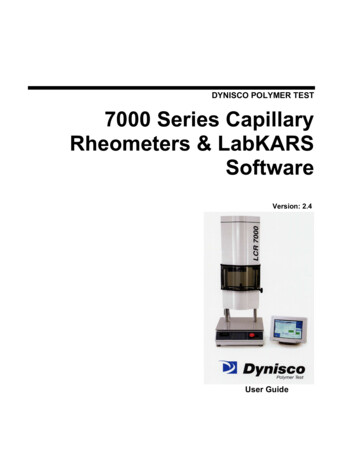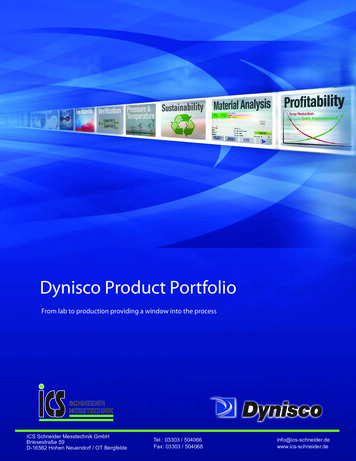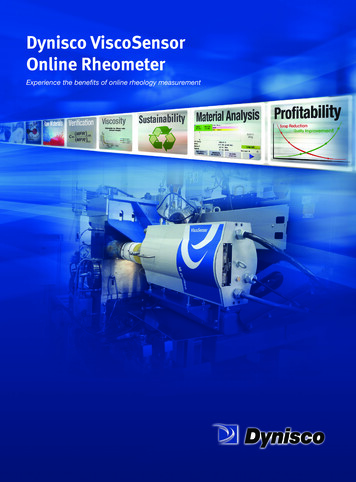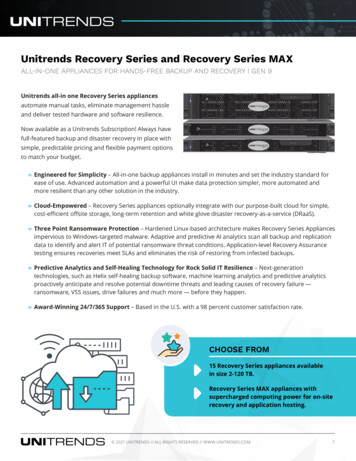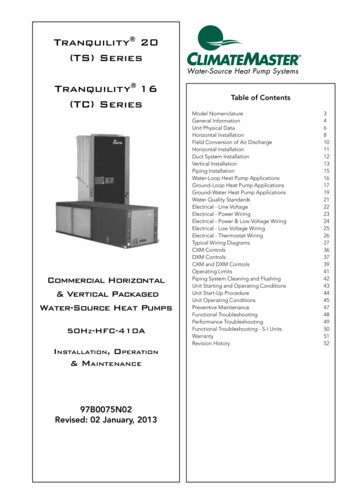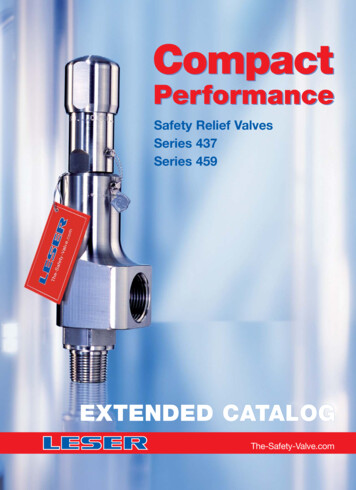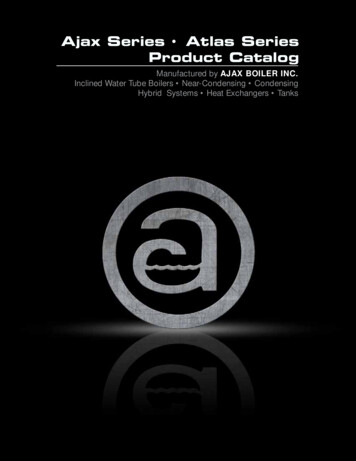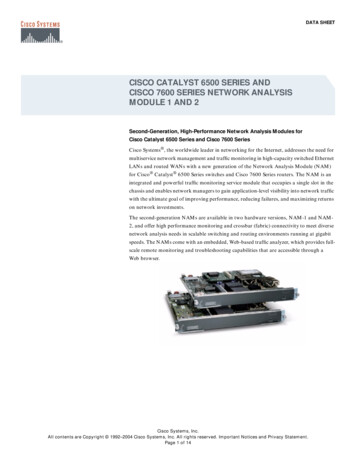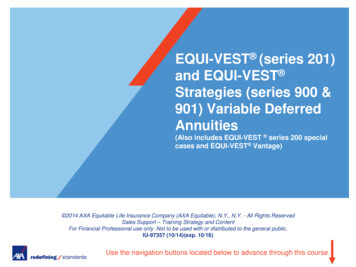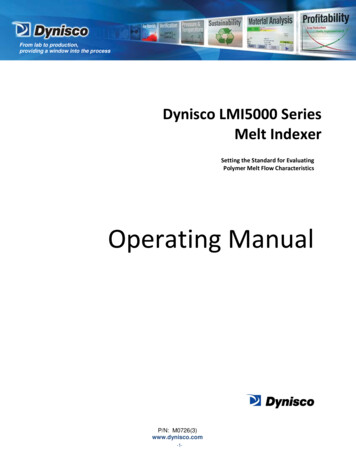
Transcription
From lab to production,providing a window into the processDynisco LMI5000 SeriesMelt IndexerSetting the Standard for EvaluatingPolymer Melt Flow CharacteristicsOperating ManualP/N: M0726(3)www.dynisco.com-1-
From lab to production,providing a window into the processSUPPORT CONTACT INFORMATIONDynisco Polymer Test can be contacted for questions and support at:By Phone and Fax:Phone 1 508 541 9400Fax 1 508 541 6206To help us handle your questions as quickly as possible, have the following items ready beforeyou call:1. Instrument name and model number (on back panel)2. Instrument serial number (on back panel)3. Current version of instrument firmware (Power up unit to see, version shown on “About”screen under “Maintenance Tab”)4. Computer system make and operating system and version (if applicable)5. Current version of LaVA Suite software (if applicable)By Internet:For Technical and Service Support: http://www.dynisco.com/polytest-servicesFor all Other Inquiries: http://www.dynisco.com/By Mail/Post:Dynisco38 Forge ParkwayFranklin, MA 02038Copyright Dynisco 2016 All Rights ReservedP/N: M0726(3)www.dynisco.com-2-
From lab to production,providing a window into the processDISCLAIMER OF WARRANTY AND LIABILITYThe information provided herein is believed to be true and correct but no warranty is given as toits completeness, accuracy or fitness for use for any particular purpose. Dynisco shall not beliable for any loss or damage arising from the failure to achieve a particular result by theapplication of any route, method or process that is recommended herein. Dynisco reserves theright to change any information, route, method, or process which is discussed or providedherein without notice. Equipment or products made prior to or subsequent to the publication dateof this manual may have parts, features, options or configurations that are not covered in thismanual.Dynisco represents that to the best of its knowledge neither the products, equipment andsystems supplied by it nor their use for the purpose for which they were supplied nor the use ofthe information or recommendation provided herein will infringe a valid patent right of any thirdparty, but no warranty, express or implied, is given in this respect.Document HistoryP/N: M0726(3)www.dynisco.com-3-
From lab to production,providing a window into the processTABLE OF CONTENTSSAFETY INSTRUCTIONS . 6Warnings, Danger and Informational Symbols . 6Safety summary. 7Use Gloves--it's very HOT! . 7Pinch Points . 9INTRODUCTION. 11SPECIFICATIONS . 12INSTRUMENT MAINTENANCE RECOMMENDATIONS . 13Equipment Setup. 14Unpacking the Indexer. 14Bench Requirements and Placement. 14Level the Melt Indexer . 15Instrument Overview. 16Front View . 16Rear View . 16Spares/Consumable Items . 17Instrument Operation/Log-In . 18Instrument Operation/Icons . 19Instrument Operation/Menus. 20Instrument Operation/Buttons . 21Instrument Operation/Miscellaneous Touch Areas . 24Instrument Operation/Panel Overview. 24Test Calculations . 25Calculations: Method A . 25Calculations for the Method A test are . 25Calculations: Method A/B . 25Calculations: Method B . 26Calculating PET Intrinsic Viscosity (I.V.) from the Melt Indexer . 27The Amount of Sample . 28Create/Edit Test Conditions . 29System Configuration . 31Selecting Multi-Select Data . 32Entering Numeric Data . 33Setting-Up a Test . 34Loading and Packing Material into the Barrel . 35Running a Test . 36Cleaning Up . 37TROUBLESHOOTING . 38Actions . 38Generic Run Check List . 38Prior to loading Sample . 38Long term items: . 39Support Vendors. 39P/N: M0726(3)www.dynisco.com-4-
From lab to production,providing a window into the processAPPENDIX A—DIGITAL ENCODER OPTION . 40APPENDIX B—PNEUMATIC LIFT . 43APPENDIX C—PNEUMATIC PACKER . 49APPENDIX D—AUTO CUTTER .51P/N: M0726(3)www.dynisco.com-5-
From lab to production,providing a window into the processSAFETY INSTRUCTIONSAll safety instructions must be understood and observed. Non-observance of safetyinstructions may cause damage to life and health of persons, environmental damage and/orextensive damage to property.Observing the safety instructions included in the operating instructions will help to avoiddangers, to operate the product profitably and to secure the full use of the product.Warnings, Danger and Informational SymbolsGeneral safety instructions concerning the activities are given at the beginning of the relevantchapter. Special safety instructions concerning the individual steps of action will be giventogether with the corresponding step of action.The following pictographs are used in the present operating instructionsP/N: M0726(3)www.dynisco.com-6-
From lab to production,providing a window into the processPlease also note that a safety symbol may never substitute the text of a safety instruction therefore, the text of a safety instruction must always be read completely!Safety summaryThe following are recommended safety precautions unrelated to any specific procedures in thismanual and therefore do not appear elsewhere. Personnel must understand and apply them asappropriate during all phases of operation and maintenance. IN ALL CASES, BE PRUDENT.P/N: M0726(3)www.dynisco.com-7-
From lab to production,providing a window into the processUse gloves--it's very HOT!To prevent burns, gloves and a long sleeve shirt (or lab coat) are essential. Dies and piston rodsare extremely hot and are designed to quickly transfer heat to the sample being tested.Unfortunately this means they will transfer heat very quickly to you as well. Even brief contactwith a hot item can cause a burn. The indexer barrel housing can also get fairly hot. However, atany barrel temperature, these should not cause burns if touched for a very brief period exceptvery near the barrel top and bottom. Consider where dies may fall. If they are dropped on Nyloncarpeting or similar materials they can quickly form holes. Protective mats may be needed.DYNISCO POLYMER TEST recommends keeping hot piston rod and hot die in thechamber/barrel; this precludes someone picking it up inadvertently.Be sure to holdthe piston by the top insulator.Electrical HazardYour Dynisco Lab Melt Flow Indexer contains high voltage inside the housing. DO NOT removethe housing or any part of its outer covers; there are no user serviceable parts inside. Serviceshould only be done by a qualified DYNISCO Service Technician. Be sure the outlet used topower the indexer is properly grounded.Calibration Thermometers may use MercuryTo calibrate the temperature on the indexer, a thermometer containing about 8 grams ofmercury may be used. Every lab with mercury thermometers or equipment containing mercurymust be prepared for breakage. Note that mercury exposed to air “evaporates” at roomtemperature, producing an invisible, tasteless, odorless and dangerous vapor. Thermometershave been used for decades in laboratory equipment and when used properly provide anaccurate and effective means of calibration. Keep the thermometer in a safe place where it willnot be crushed or otherwise broken. When using the thermometer be careful not to drop orbend the glass. Place a hot thermometer onto cotton patches to cool. Never put a hotthermometer in contact with cold metal or cold solvent because the thermal shock can crack orshatter the glass. Mercury is extremely toxic and should be handled accordingly.A material safety data sheet (MSDS) for mercury (Hg) can be found on the Internet. Observelocal, state and federal hazardous waste disposal laws when disposing of any brokenthermometers. If packaged in a sealed plastic container and labeled with the following symbol:P/N: M0726(3)www.dynisco.com-8-
From lab to production,providing a window into the processPinch PointsDo not place weights in precarious positions where they can be bumped and fall to the floor. Forlarge test weights (over 10 kg) the pneumatic lift system is recommended. The lift systemhas a mechanical capture rod which will not allow the weights to “fall” out of the machine. Whenthe machine is in operation the lift system moves the weight downward somewhat quicklycreating an area where anything lying beneath could be crushed. The lift system has a safetydoor that, when installed correctly and not tampered with, will prevent the lift from moving whenopen. There are redundant internal firmware and mechanical hardware safeties in place in thelift system.Fumes from MaterialsPlease plan for unexpected issues to arise. Many polymers (PVC, PVF etc.) are well known forgiving off hazardous fumes at elevated temperatures. An exhaust system that removes fumesfrom both the die exit and near the top of the barrel is strongly recommended. Considerationshould also be given to additives that may degrade or decompose at elevated testtemperatures.Obligation of the operator to exercise due careThe LMFI was designed and constructed taking into consideration a hazard analysis havingcarefully adhering to the harmonised safety standards as well as further technicalspecifications. Thus, the LMFI conforms to the state of the art technology and ensures amaximum of safety.In practical operation, this safety can, however, be achieved only if all necessary measures aretaken. The obligation of the plant operator to exercise due care includes planning thesemeasures and supervising their execution.Especially, the operator has to ensure that:1. The LMFI will be used only in accordance with the intended purpose.2. The LMFI will be operated in a flawless, functionally efficient condition and that, inparticular, the functional efficiency of the safety devices will be checked at regularintervals.3. No modifications will be made to the component except by a Dynisco service person.4. The necessary personal protective equipment for the operation, maintenance, andservice will be available and used by any personnel performing these functions.P/N: M0726(3)www.dynisco.com-9-
From lab to production,providing a window into the process5. The operating instructions are always available completely and fully legible at theinstallation location of the LMFI. It must be guaranteed that all persons who work withthe LMFI can consult the operating instructions at any time.6. Only sufficiently qualified and authorized personnel will operate, maintain, and repair theLMFI.7. All safety and warning labels, attached to the LMFI, must not be removed and mustremain fully legible.8. Additional instructions, in accordance with facility, local, state and federal industrialsafety regulations and their corresponding, related ordinances for the use of workmaterials, will have to be made available as a supplement to the operating instructions.P/N: M0726(3)www.dynisco.com-10-
From lab to production,providing a window into the processINTRODUCTIONA flow rate test is a measure of a polymer's mass flow rate (grams extruded in 10 minutes)using a particular orifice under specified conditions of temperature and load. Machines thatdetermine flow rate are generally called Melt Indexers. Test methods by ISO, DIN, ASTM andothers specify heat chamber and piston tip diameter such that the shear stress on the polymeris the same in all machines for a given load. In addition, material specification guidelines (byISO, DIN, ASTM, GM etc) may exist which give further constraints on how a particular type ofmaterial may be run.The tests performed are those described by ASTM D1238 and ISO 1133-1, 1133-2. Thismanual in no way supersedes either of these documents. The precision and accuracy of the testhas been determined by ASTM method D1238. Contributing to both precision and accuracy areoperator variances such as; packing technique, cleaning, cutting, weighing etc. With moisturesensitive polymers, dryness can also play a major role, and time can be a factor with thermallyunstable polymers, so procedures must be identical. Dynisco Polymer Test Systems has foundthat charging a consistent mass of material into the barrel ( 0.1 grams) is the most critical factorin getting precise data.Several methods have been developed for running flow rate tests under D1238, with Methods A(mass of material over time) and B (volume of material over time) being the basic of all methods.Method A is simply the collection of extrudate over time, while Methods B, C and D are themeasurement of time for the flow of a fixed volume of polymer. All but Method A require anencoder to measure distance traveled to determine volume of material extruded during the test.P/N: M0726(3)www.dynisco.com-11-
From lab to production,providing a window into the processSPECIFICATIONSUTILITIES:Electrical Requirements: 100-120 VAC / 220-230 VAC, 6A/4A-Peak at Power-up, 5A/2.5A,500VA-normal operational power, 50 Hz / 60 HzPNEUMATICS:Lift Option (PSI/Bar): MIN: 60/4.2 MAX: 80/5.5Packer Option (PSI/Bar): MIN: 20/1.4 MAX: 50/3.5Instrument with weight system could have up to 70lbs/31.6Kg weights installed (shippeduninstalled with unit).OTHER:Complies with ISO ASTM D1238 and ISO 1133-1, ISO 1133-2.P/N: M0726(3)www.dynisco.com-12-
From lab to production,providing a window into the processINSTRUMENT MAINTENANCE RECOMMENDATIONSDaily: Remove the orifice and clean thoroughly with brush and precision drill bit. Clean yourindexer barrel with cotton patches when hot. Piston should spin easily when placed into aclean barrel.Weekly: Give good cleaning with brass brush. Use oven cleaner to clean the piston rodexposed metal and orifice.Monthly or Long Term: Depending on your company policy, a calibration or calibration checkmay be needed on a monthly, quarterly or yearly basis. It is a recommended that a repetitivemaintenance schedule be created for your instrument.Clean unit: Clean the dust and dirt out of the electronics module with clean air every sixmonths to one year, more often in dirty environments. Perform this with power removed fromthe system. Remove the orifice and clean thoroughly. Clean your barrel. Use oven cleaner toclean the piston rod assembly and orifice.Check Mechanical Tolerances: All dimensions and tolerances per ASTM D1238 and ISO1133-1. Piston tip diameter 0.3730”/9.474mm /-0.0003”/0.0076mm; piston tip length 0.2500”/6.35mm /- 0.0050”/0.127mm. Assembled piston rod weighs 100 grams. GO/NO-GOgage works properly on the orifice. Orifice length 0.3150”/8mm /- 0.0010”/0.0254mm.Weights still weigh correctly. Digital Encoder calibration. Gages can be purchased fromDynisco Polymer Test.Barrel Diameter: Once the barrel is extremely clean, all dimensional measurements are to bemade at room temperature it can be checked using a bore gage. Gage can be purchased fromDynisco Polymer Test. At the time of manufacture, the barrel center bore measures0.3760”/9.55mm /- 0.0002”/0.00508mm. All dimensions and tolerances per ASTM D1238 andISO 1133-1.Pneumatic Lift maintenance: The guide rod and the pneumatic cylinder rod can be lubricated.Dynisco Polymer Test suggests that WD-40 o
Dynisco Polymer Test can be contacted for questions and support at: By Phone and Fax: Phone 1 508 541 9400 Fax 1 508 541 6206 To help us handle your questions as quickly as possible, have the following items ready before you call: 1. Instrument name and model number (on back panel) 2. Instrument serial number (on back panel) 3.File Size: 1MB

